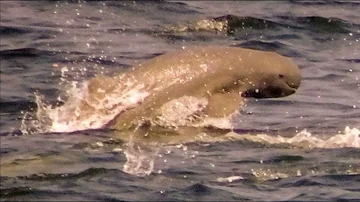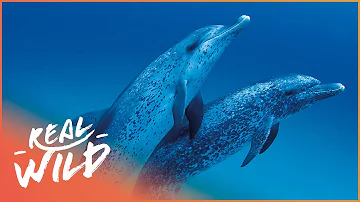
Irrawaddy Dolphin
Orcaella brevirostris

Meet the Irrawaddy Dolphin
The Irrawaddy dolphin is a unique aquatic mammal known for its rounded head, lack of a beak, and expressive facial features. It inhabits coastal, estuarine, and freshwater environments across South and Southeast Asia, including the Irrawaddy, Mekong, and Mahakam rivers. Unlike most oceanic dolphins, Irrawaddy dolphins are adapted to both saltwater and freshwater habitats and are often found far upriver. They are highly social, living in small groups, and are known for their cooperative behavior, sometimes working with fishermen. This species faces significant threats from habitat loss, fishing gear entanglement, and water pollution.
Classification
Mammal
Habitat
Freshwater rivers, coastal waters, and estuaries
Diet
Carnivore
Lifespan
30–40 years
Conservation
Endangered
Weight
90–200 kg
📖Fascinating Facts
Freshwater Specialist
Unlike most dolphins, Irrawaddy dolphins thrive in freshwater rivers as well as coastal and estuarine habitats.
Fishermen Allies
In parts of Myanmar, Irrawaddy dolphins collaborate with fishermen, herding fish into nets for mutual benefit.
Expressive Faces
They have a distinctive, rounded forehead and flexible neck, giving them a highly expressive and unique appearance among dolphins.
📋Detailed Description
The Irrawaddy dolphin (Orcaella brevirostris) is a medium-sized cetacean notable for its robust, stocky body, rounded forehead (melon), and absence of a beak, distinguishing it from most other dolphins. Adults typically measure 2.0–2.75 meters in length and weigh between 90 and 200 kilograms. Their coloration ranges from pale slate blue to gray, with a lighter underside. The dorsal fin is small, triangular, and set about two-thirds along the back, while the pectoral fins are broad and paddle-shaped. Irrawaddy dolphins possess 12–19 pairs of teeth in each jaw, adapted for grasping slippery prey. They have a flexible neck due to unfused cervical vertebrae, allowing for a wide range of head movement. Socially, they form small, fluid groups of 2–7 individuals, though aggregations of up to 25 have been observed in productive areas. These dolphins are highly vocal, using clicks, buzzes, and whistles for echolocation and communication. Their distribution includes brackish coastal waters, estuaries, and several major river systems in South and Southeast Asia, with isolated subpopulations in places like the Mekong, Mahakam, and Ayeyarwady Rivers, as well as Chilika and Songkhla Lakes. They are slow, deliberate swimmers, surfacing at irregular intervals, and are known for their shy, elusive nature. Irrawaddy dolphins exhibit cooperative behaviors, sometimes working with local fishermen to herd fish into nets, a rare example of interspecies collaboration.
💡 Did you know?
Irrawaddy dolphins have a unique partnership with some local fishermen in Myanmar, where the dolphins help herd fish into nets in exchange for a share of the catch.
🔬Research & Sources
Wikipedia Summary
The Irrawaddy dolphin is a euryhaline species of oceanic dolphin found in scattered subpopulations near sea coasts and in estuaries and rivers in parts of the Bay of Bengal and Southeast Asia. It closely resembles the Australian snubfin dolphin, which was not described as a separate species until 2005. It has a slate blue to a slate gray color. Although found in much of the riverine and marine zones of South and Southeast Asia, the only concentrated lagoon populations are found in Chilika Lake in Odisha, India and Songkhla Lake in southern Thailand.
Last Modified: 5/29/2025
🎭Behavior & Social Structure
Irrawaddy dolphins are diurnal, with peak activity in the early morning and late afternoon. They exhibit a variety of foraging strategies, including herding fish into shallow waters or mud-plume feeding, where they stir up sediment to disorient prey. Their diet consists mainly of fish, crustaceans, and cephalopods. Dolphins in riverine habitats often exploit seasonal fish migrations. Social interactions are complex; individuals engage in tactile behaviors such as rubbing and synchronous swimming. Vocalizations are used for navigation, prey detection, and social cohesion. They are generally non-acrobatic, rarely leaping, but may spyhop or tail-slap. Group cohesion is maintained through frequent contact, and calves are often seen swimming in echelon position beside their mothers. Cooperative fishing with humans has been documented, particularly in Myanmar, where dolphins signal fishermen to cast nets and share in the catch.
👶Reproduction & Life Cycle
Irrawaddy dolphins have a polygynous mating system, with breeding occurring throughout the year but peaking during the rainy season (May–October) in some regions. Females reach sexual maturity at 7–9 years, males slightly later. Gestation lasts approximately 14 months, after which a single calf, measuring about 1 meter in length, is born. Calving intervals are estimated at 2–3 years. Neonates are nursed for at least 6–12 months, during which time the mother provides extensive care and protection. Calves remain closely associated with their mothers for up to two years, learning foraging and social behaviors. There is little evidence of alloparental care, but group members may assist in protecting calves from threats.
🛡️Adaptations & Survival
Irrawaddy dolphins are uniquely adapted to both freshwater and marine environments (euryhaline), tolerating wide salinity ranges. Their flexible necks enhance maneuverability in shallow, complex habitats. The rounded melon aids in echolocation, crucial for navigation and prey detection in turbid waters. Their small dorsal fin and broad pectoral fins facilitate slow, precise movements in confined spaces. They can close their blowholes tightly, an adaptation for diving in muddy or debris-laden rivers. Behavioral adaptations include cooperative hunting and the use of mud plumes to trap prey. Physiologically, they have specialized kidneys to regulate osmotic balance in varying salinities.
📚Research Sources
🎨Cultural Significance
Irrawaddy dolphins hold cultural importance in several Southeast Asian communities. In Myanmar, they are revered as helpers of fishermen, with traditional beliefs attributing them with spiritual qualities and good fortune. Folklore often depicts them as protectors of riverine communities. In Cambodia and Laos, they are featured in local legends and are considered symbols of healthy rivers. Ecotourism centered on dolphin-watching has become an important source of income in some areas, fostering local stewardship. However, there is little evidence of direct exploitation for food or traditional medicine in recent decades.
🔬Recent Research & Discoveries
Recent genetic studies have clarified the distinction between Irrawaddy dolphins and the closely related Australian snubfin dolphin (Orcaella heinsohni), supporting their status as separate species. Ongoing research focuses on population genetics, acoustic communication, and the impacts of environmental contaminants. Satellite telemetry has provided insights into movement patterns and habitat use, revealing strong site fidelity in some subpopulations. Conservation research emphasizes community engagement and the development of bycatch mitigation technologies. Notably, studies in Chilika Lake and the Mekong River have informed management plans and highlighted the importance of transboundary conservation efforts.
🎥Wildlife Videos

Irrawaddy Dolphin: The SMARTEST River Hunter! 🏞️🔥
Irrawaddy Dolphin: The SMARTEST River Hunter! 🏞️ Did you know the Irrawaddy Dolphin is one of the rarest and most ...
Ases World

Exploring the Secret Lives of Dolphins | 4K Nature Documentary
In this documentary, follow the extraordinary journey of biologist Angela Ziler and dolphin expert Michael Scherman as they study ...
Real Wild

Dolphins off the Coast of New Zealand - Wild Dolphins - Full Nature Documentary
The different dolphin species living in the waters surrounding New Zealand have all evolved unique strategies to survive in their ...
Get.factual

Facts: The Irrawaddy Dolphin
Quick facts about this very endangered aquatic mammal that likes to help fishermen! The Irrawaddy dolphin (Orcaella brevirostris).
Deep Marine Scenes

The Incredible Life Of Dolphins | Changing Seas | Real Wild
Dr. Denise has dedicated her career to learning about how dolphins communicate, behave, and socialize in one area of the ...
Real Wild

Irrawaddy Dolphins Swimming in the Mekong
The trademark curved mouth of the Irrawaddy dolphin led to the animal's nickname: the "smiling face of the Mekong." They travel ...
World Wildlife Fund
🌍Habitat Information
The Irrawaddy Dolphin typically inhabits Freshwater rivers, coastal waters, and estuaries environments. Irrawaddy Dolphins have adapted to their environments with specialized features and behaviors.
Primary Habitat:
Freshwater rivers, coastal waters, and estuaries
More detailed habitat information will be available soon.
🛡️Conservation Status
The Irrawaddy Dolphin is currently classified as Endangered. Conservation efforts are crucial for preserving this species for future generations.
Common Threats:
- 🏠Habitat loss and fragmentation
- 🌡️Climate change impacts
- 🎯Hunting and poaching
- 🏭Human-wildlife conflict
⚠️Threats & Conservation Challenges
Irrawaddy dolphins face severe threats from accidental bycatch in gillnets and electrofishing, habitat fragmentation due to dam construction, water pollution (including heavy metals and pesticides), and vessel traffic. Population fragmentation and small subpopulation sizes exacerbate vulnerability to stochastic events. In some regions, intentional capture for live display or traditional medicine persists. The species is listed as Endangered by the IUCN, with some riverine populations (e.g., Mekong, Mahakam) numbering fewer than 100 individuals. Conservation challenges include enforcing fishing regulations, mitigating habitat degradation, and fostering community-based protection. Population trends are generally declining, with local extinctions reported in parts of their historical range.
🔬Scientific Classification
Scientific Name
Orcaella brevirostris
Classification Hierarchy
🔍 About Taxonomic Classification
Taxonomic classification is a hierarchical system used by scientists to classify and organize living organisms based on shared characteristics and evolutionary relationships.
The system moves from broad categories (Kingdom) to increasingly specific ones, with each animal's scientific name typically consisting of its Genus and species.
📝Community Notes
Share your observations and insights about the Irrawaddy Dolphin with our community of wildlife enthusiasts.
Join Our Community
Sign in to share your observations and connect with fellow wildlife enthusiasts.
Sign In to ContributeNo community notes yet
Be the first to share your observations about the Irrawaddy Dolphin!
Explore Irrawaddy Dolphin
Select a tab above to learn more about this amazing animal.
📸Photo Gallery
No photos available for this animal yet.
🌟Discover More Wildlife
Continue your journey of discovery with more fascinating animals from our database
